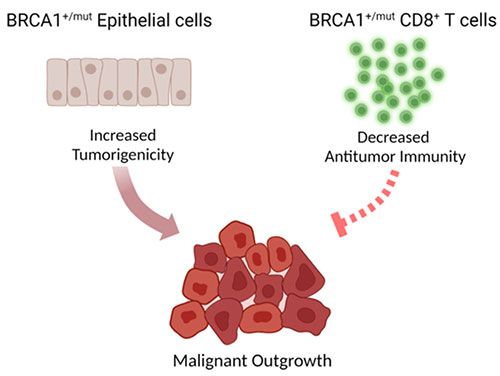Crosstalk between adipocytes, immune cells and tumor cells in the breast tumor microenvironment
Our significant research efforts in recent years have been focused on the intricate interplay between tumor cells, extracellular matrix, and different stromal cells including adipocytes and immune cells during breast cancer progression. For example, we found that adipocytes express high levels of immune checkpoint protein PD-L1, which in turn modulates antitumor immunity and anti-PD-1/PD-L1 immunotherapies (J ImmunoTher Cancer, 2020). In a separate study, we found multiple roles of the collagen receptor DDR1 in cancer progression, including regulation of stromal hormone output and exclusion of antitumor immune cells (Nature, 2021). Our ultimate goal in this line of work is to enhance therapeutic efficacy of cancer treatment by targeting newly discovered signaling molecules involved in adipose-immune-tumor crosstalk.

Why do germ-line BRCA1 mutations increase breast cancer risk?
Women who harbor cancer-predisposing germ-line mutations in BRCA1 have a significantly increased chance of developing breast cancer. However, it is not clear whether the DNA repair activity of BRCA1 in breast epithelial cells alone is sufficient to account for its sex- and tissue-specific tumor suppression function. We discovered a previously unrecognized, DNA repair-independent functional interaction between BRCA1 and an RNA polymerase II pausing factor in mammary gland development and tumor development (Nature Commun, 2016; Nature Commun, 2017). More recently, we found that BRCA1 deficiency in adaptive immunity could contribute to tumorigenesis (J ImmunoTher Cancer, 2022). Our long-term objective in this project is to reconcile an enduring intellectual disconnect concerning BRCA1-associated cancer, thus catapulting understanding of BRCA1 cancer biology to a new level. We also propose that prophylactic boosting of adaptive immunity may reduce cancer incidence among at-risk women.
